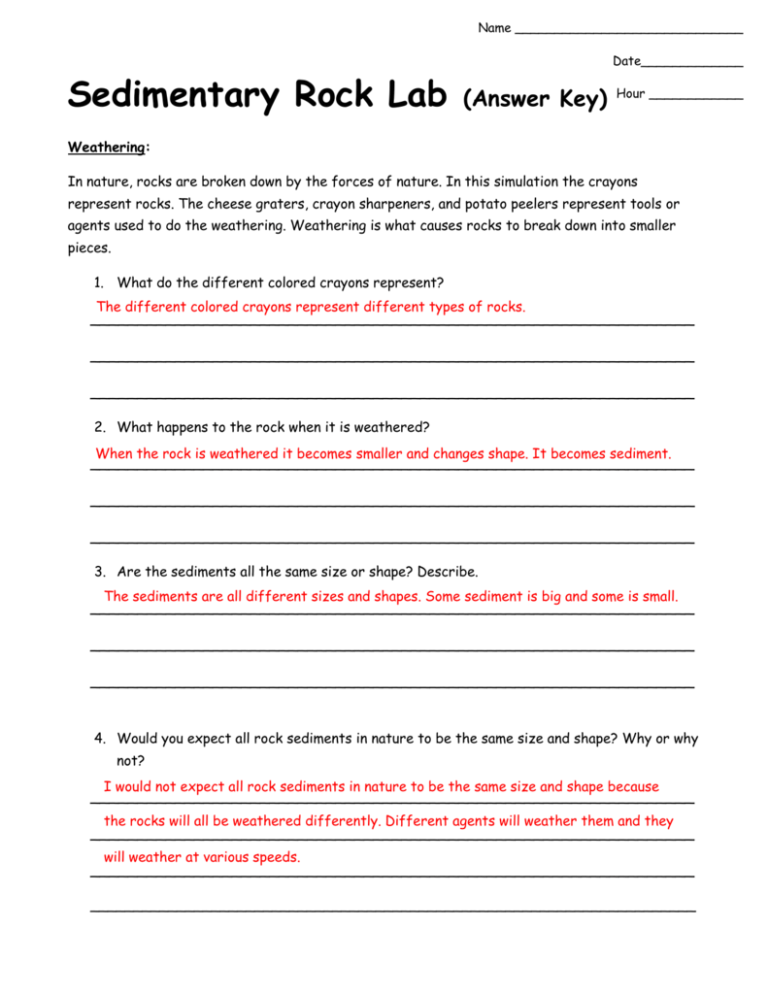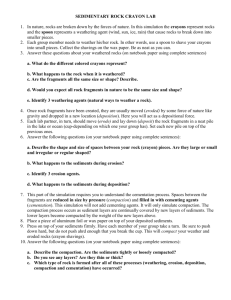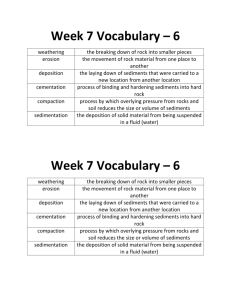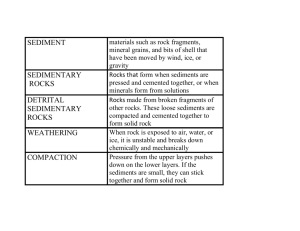Sedimentary-Rock-Lab-Answer
advertisement

Name _____________________________ Sedimentary Rock Lab Date_____________ (Answer Key) Hour ____________ Weathering: In nature, rocks are broken down by the forces of nature. In this simulation the crayons represent rocks. The cheese graters, crayon sharpeners, and potato peelers represent tools or agents used to do the weathering. Weathering is what causes rocks to break down into smaller pieces. 1. What do the different colored crayons represent? The different colored crayons represent different types of rocks. ________________________________________________________________ ________________________________________________________________ ________________________________________________________________ 2. What happens to the rock when it is weathered? When the rock is weathered it becomes smaller and changes shape. It becomes sediment. ________________________________________________________________ ________________________________________________________________ ________________________________________________________________ 3. Are the sediments all the same size or shape? Describe. The sediments are all different sizes and shapes. Some sediment is big and some is small. ________________________________________________________________ ________________________________________________________________ ________________________________________________________________ 4. Would you expect all rock sediments in nature to be the same size and shape? Why or why not? I would not expect all rock sediments in nature to be the same size and shape because ________________________________________________________________ the rocks will all be weathered differently. Different agents will weather them and they ________________________________________________________________ will weather at various speeds. ________________________________________________________________ ______________________________________________________________________ 5. Explain how the crayons in this activity are used as a model to show the weathering of rocks. The crayons in the activity are used as a model to show the weathering of rocks because ________________________________________________________________ The crayons in the activity are used as a model to show the weathering of rocks because ________________________________________________________________ ________________________________________________________________ ______________________________________________________________________ Erosion: Once rock fragments or sediments have been created, they are usually moved (eroded) by some force of nature and dropped in a new location. Here you or the teacher will act as erosion. The sediments will be moved (erode) and layed down in a neat pile in the center of your wax paper. 6. Describe the shape and size of spaces between your rock (crayon) pieces. Are they large or small and irregular or regular shaped? The shape and size of the spaces between the crayon pieces are both small and large and ________________________________________________________________ irregular in shape. The crayon pieces are very loose and far apart from each other. ________________________________________________________________ ________________________________________________________________ ______________________________________________________________________ 7. What happens to the sediments during erosion? The sediments are moved or transported from one location to another during erosion. ________________________________________________________________ ________________________________________________________________ ________________________________________________________________ ______________________________________________________________________ Compaction and Cementation: This part of the simulation requires you to understand the cementation process. Spaces between the fragments are reduced in size by pressure (compaction) and filled in with cementing agents (cementation). This simulation will not add cementing agents. It will only simulate compaction. The compaction process occurs as sediment layers are continually covered by new layers of sediments. The lower layers become compacted by the weight of the new layers. Challenge: You have weathered crayons into crayon sediments. Your challenge is to think of a plan that will combine the samples into one solid piece again. The plan for this sediment does NOT include heating, melting, or water. Write your plan for combining the group sediments. Answers will vary 8. Describe the compaction. Are the sediments tightly or loosely compacted? The sediments are tightly compacted. ________________________________________________________________ ________________________________________________________________ 9. Do you see any layers? Are they thin or thick? Answers will vary. ________________________________________________________________ ________________________________________________________________ 10. Explain how what you did to compact the crayon sediment models compaction with real rocks. How is the simulation of compaction different from the real process? The simulation of compaction is different from the real process in that the real process ________________________________________________________________ takes a lot more time and a lot more pressure. The processes are the same in that ________________________________________________________________ pressure is applied to both in order for the rock to form. ________________________________________________________________ ________________________________________________________________ Conclusion: Draw and label a diagram of how sedimentary rocks are formed including the four main processes used to form sedimentary rocks.








